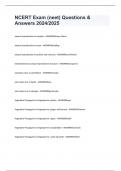Exam (elaborations)
NCERT Exam (neet) Questions & Answers 2024/2025
- Course
- Institution
NCERT Exam (neet) Questions & Answers 2024/2025 asexual reproduction in amoeba - ANSWERSbinary fission asexual reproduction in yeast - ANSWERSbudding asexual reproduction in protists and moneras - ANSWERScell division chlamydomonas asexual reproduction structure - ANSWERSzoospores ...
[Show more]




